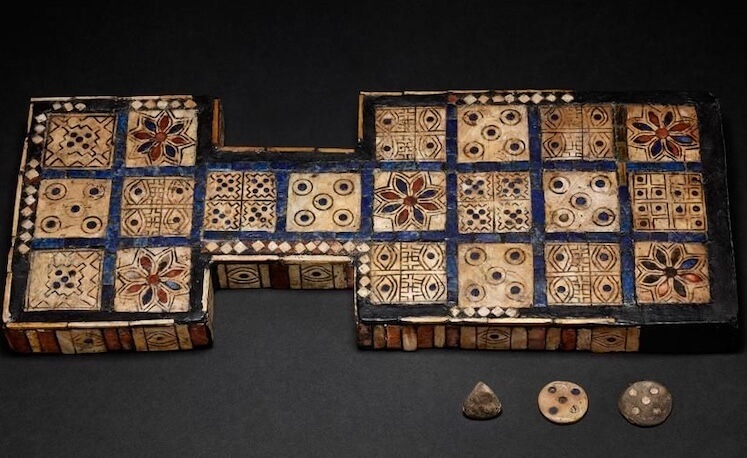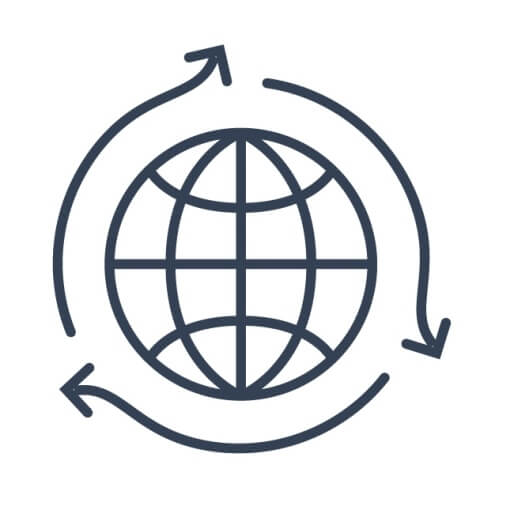The first civilisation in human history is thought to be that of Sumer located in Southern Mesopotamia (modern Iraq). Boards found in the ancient Sumerian royal tombs at Ur (~2600BC) seem to be some sort of race game. The Sumerian name of the game is not known although it is often referred to as the Royal Game of Ur.

The stunning Royal Game of Ur held by the British Museum
| Time | Key event |
|---|---|
| 2600–2400 BC Wood and shell, found in the Royal Cemetery of Ur, south Iraq, 2600–2400 BC. | The Royal Game of Ur is the oldest playable boardgame in the world, originating around 4,600 years ago in ancient Mesopotamia. The game's rules were written on a cuneiform tablet by a Babylonian astronomer in 177 BC. From this, curator Irving Finkel was able to decipher the rules – two players compete to race their pieces from one end of the board to the other. The central squares were also used for fortune telling. |
| 400 BC Genesis of board games. | The genesis of board games used for war gaming. The author of The Art of War Sun-Tzu mentions a simulation game used to teach his students strategy. He calls it "Wei-Ha," a game that probably evolved into the game of Go. During the same period, the ancient Indian strategy game Chaturanga was created. (Wilson, 1968) This game was believed to be the predecessor of modern-day Chess. |
| 1600s Chess evolves. | Chess in Europe was adapted to reflect better recent military developments. Versions of chess were spun-off to simulate more realistic military situations (Sayre, 1912). |
| 1700s First military simulation. | Prussian army developed Kriegsspiel. This type of game was designed to teach officers military tactics. (Thomas, 1957) |
| 1928 Game theory born | Game theory developed. John Von Neumann publishes his first paper on game theory. (von Neumann, 1928) |
| 1932 First factory simulation | The first factory simulation was created in Leningrad, The Soviet Union, by Mary Mironovna Birshtein. Also known as the “mother of simulation gaming”, she taught managers how to handle operations problems through “typewriter factory” simulation. Birshtein would create more than 40 realistic and ambitious simulations. (Gagnon, 1987) |
| 1939-1945 -- World War 2 Advanced military simulation | During WW2, several documented uses of wargames were used to simulate battles and train officers. • Germany used games to simulate their invasion of France. • Japan organized simulation exercises to foresee how campaigns would develop, including the attack on Pearl Harbor. (Hausrath, 1971) • Using a simulation, the United Kingdom prepared naval officers to fight the German submarine packs "wolfpacks" during the Battle of the Atlantic. (Parkin,2020) This simulation was facilitated by Wrens (members of the Women's Royal Naval Service). |
| 1952 Simulations in corporations | First documented civil use of simulations in the US. Rand Corporation’s Systems Research Laboratory. The simulation was adapted WW2 Air Defense Center under attack. The goal was to simulate complex systems and understand adaptation process in realistic laboratory conditions. (Chapman, et al,1959) |
| 1956 The first computer business simulation | The first computer business simulation AMA TOP MANAGEMENT DECISION SIMULATION, developed by the American Management Association from 1956 (Kriz, 2017). |
| 1950’s Growing usage of business simulations | Increased usage of paperback business simulations. More than 100 were developed (Kibbee, 1961). Although the modern computer has been invented by that point, it was relatively expensive and scarce. Therefore, the first business simulations were scored by hand. Some examples of business games from that period are Business Management Game (Andlinger, 1958) and UCLA Executive Decision Game No. 2 1958 (Wagner, 1965). |
| 1962 The first video game. | The first computer video game Spacewar! was developed. |
| 1960’s to 2000’s The proliferation of business simulations | Thousands of online and paperback business games (simulations) are developed and widely used by private companies, governments, and universities. (Kriz, 2017) |
| 2002 | The “gamification” term was coined (Corona Martínez, et al, 2019) |
REFERENCES
– Andlinger, G. (1958). BUSINESS GAMES – PLAY ONE. Harvard Business Review, 36(2), 115–125.
– Chapman, R. L., Kennedy, J. L., Newell, A., & Biel, W. C. (1959). The Systems Research Laboratory’s Air Defense Experiments. Management Science, 5(3), 250–269.
– Corona Martínez, D., & Real García, J. (2019). Using Malone’s Theoretical Model on Gamification for Designing Educational Rubrics. Informatics, 6(1), 9. MDPI AG. Retrieved from http://dx.doi.org/10.3390/informatics6010009
– Gagnon, J. H. (1987). Mary M. Birshtein: The Mother of Soviet Simulation Gaming. Simulation & Games, 18(1), 3–12.
– Hausrath, Alfred Hartmann. (1971). Venture simulation in war, business, and politics. New York : McGraw-Hill
– Kibbee, J. M. (1961). Management games; a new technique for executive development. Reinhold Pub. Corp.
– Kriz, W. C. (2017). Historical Roots and New Fruits of Gaming and Simulation. Simulation & Gaming, 48(5), 583–587.
– Parkin, S. (2020). A Game of Birds and Wolves: The Ingenious Young Women Whose Secret Board Game Helped Win World War II. Little, Brown.
– Sayre, F. (1912). Map maneuvers and tactical rides. Springfield, MA: Springfield Printing and Binding Co.
– Thomas, C.J. (1957). The genesis and practice of operational gaming. Proceedings of the First International Conference on Operational Research, p 65-81.
– von Neumann, J (1928). “Zur Theorie der Gesellschaftsspiele”. Mathematische Annalen (in German). 100: 295–320.
– Wagner, A. B. (1965). The Use of Process Analysis in Business Decision Games. The Journal of Applied Behavioral Science, 1(4), 387–408.
– Wilson. (1969). The Bomb and the Computer: Wargaming from Ancient Chinese Mapboard to Atomic Computer. Delacorte Press.





